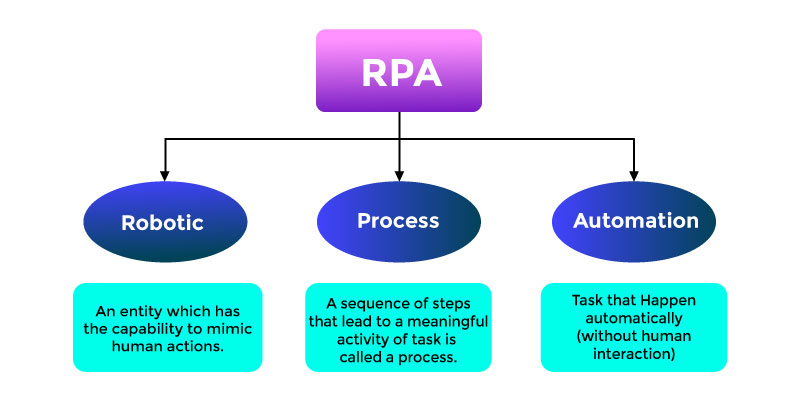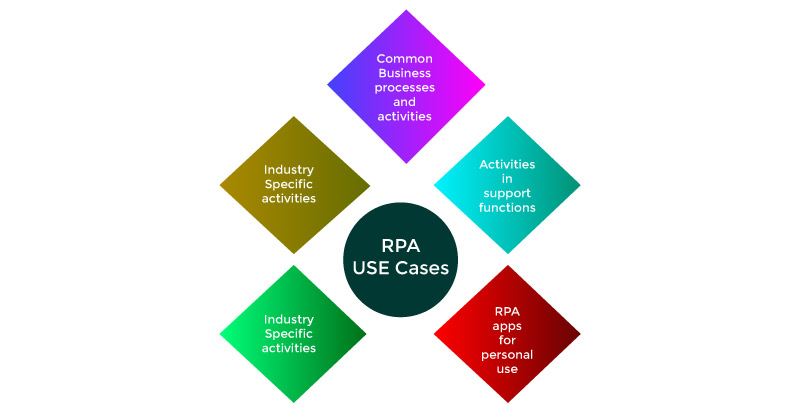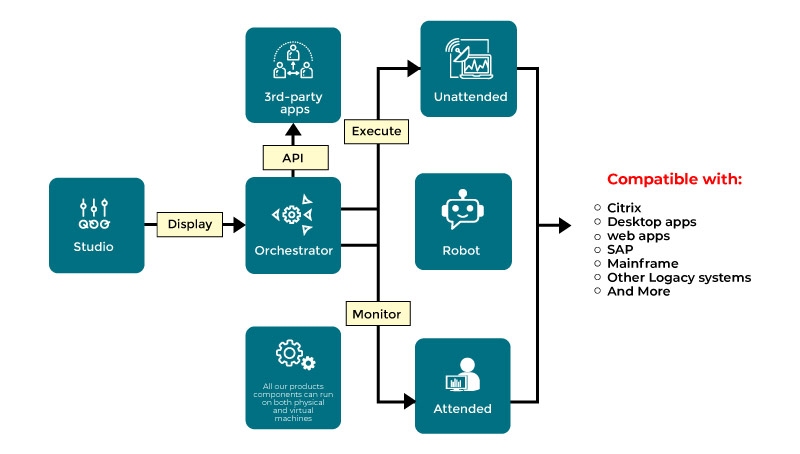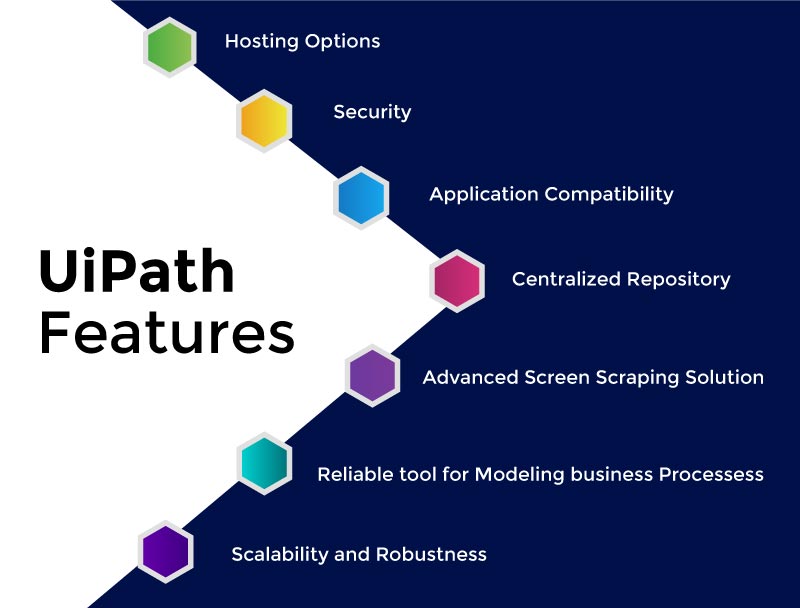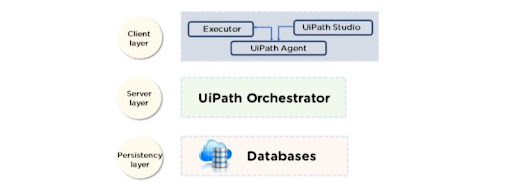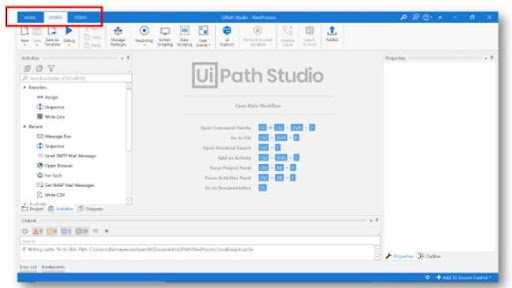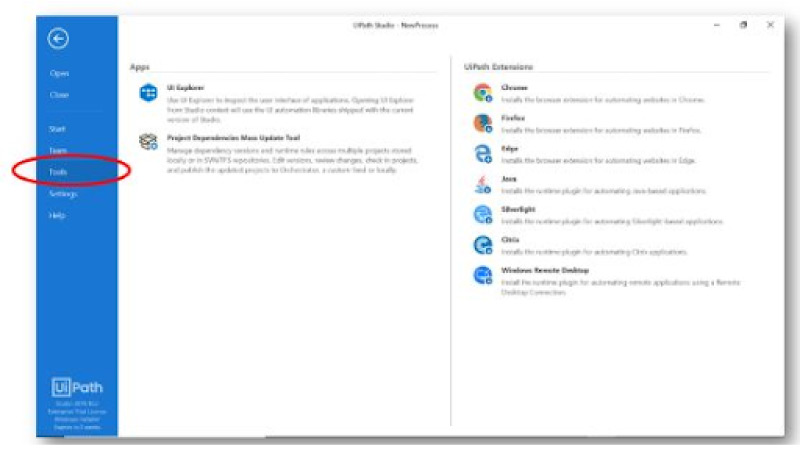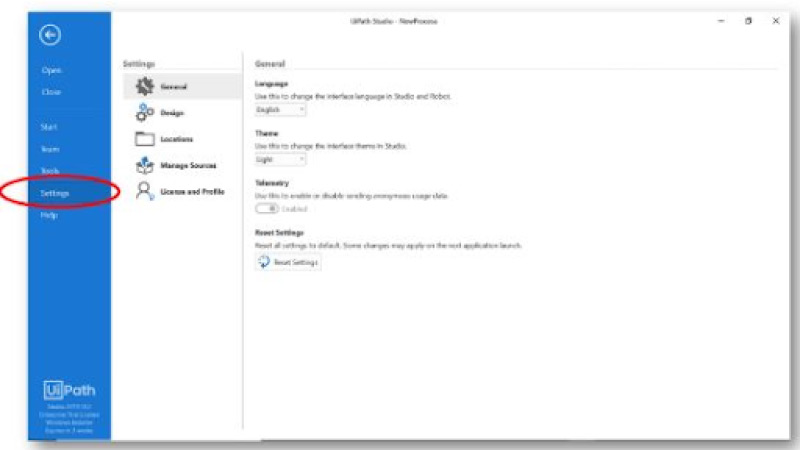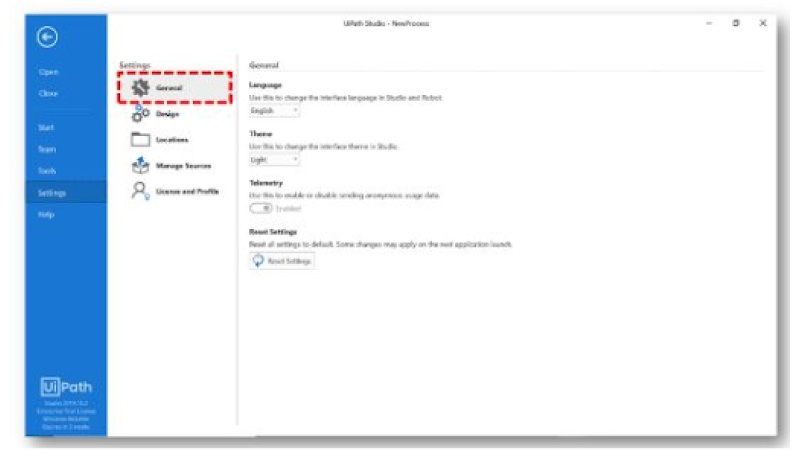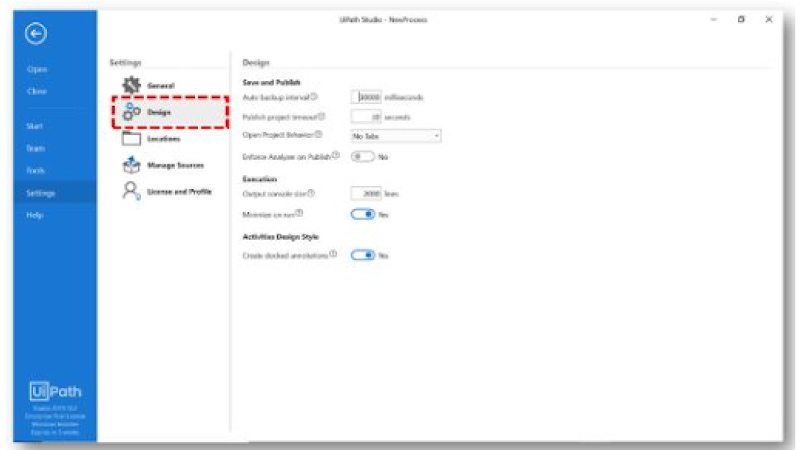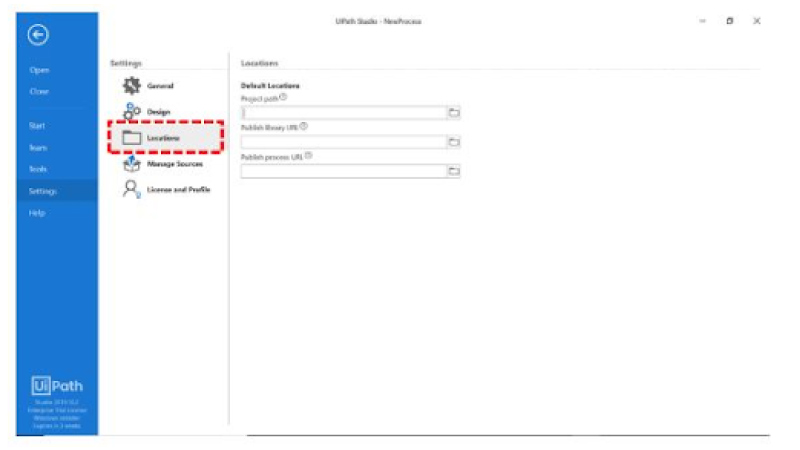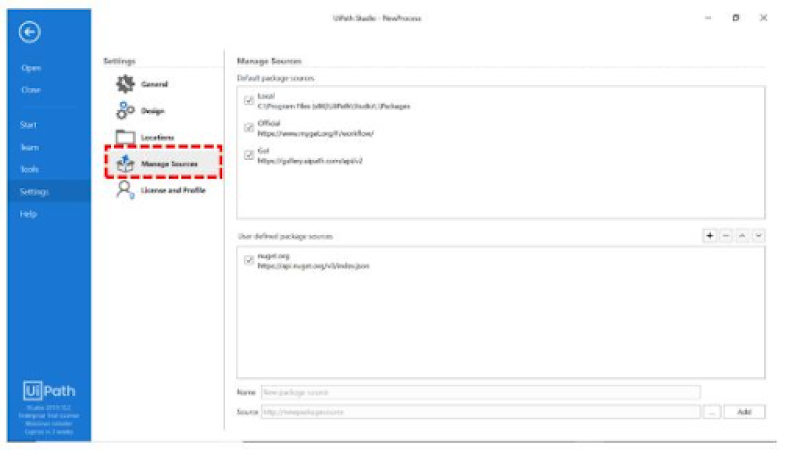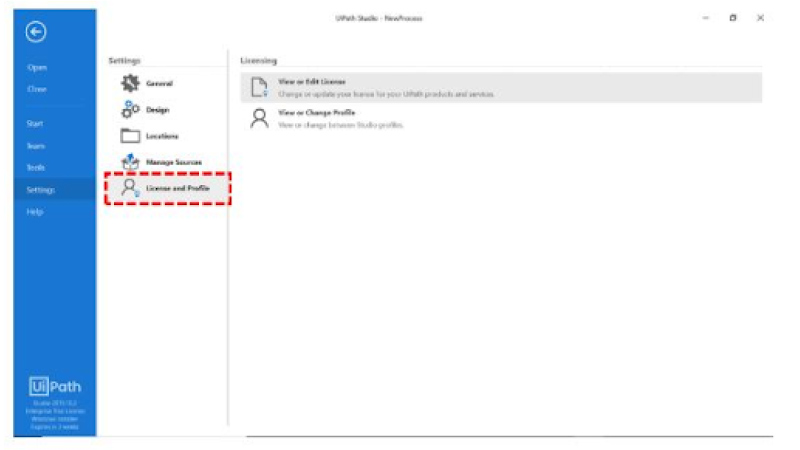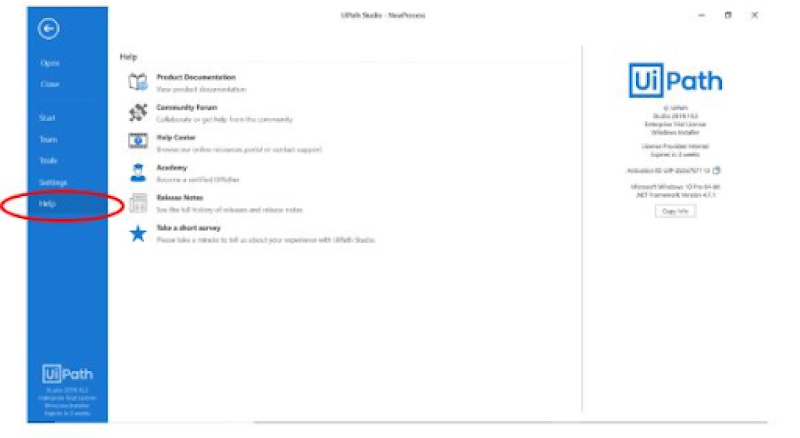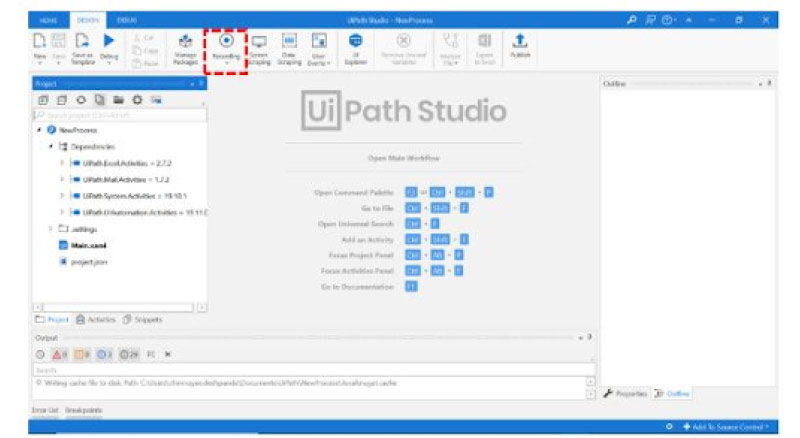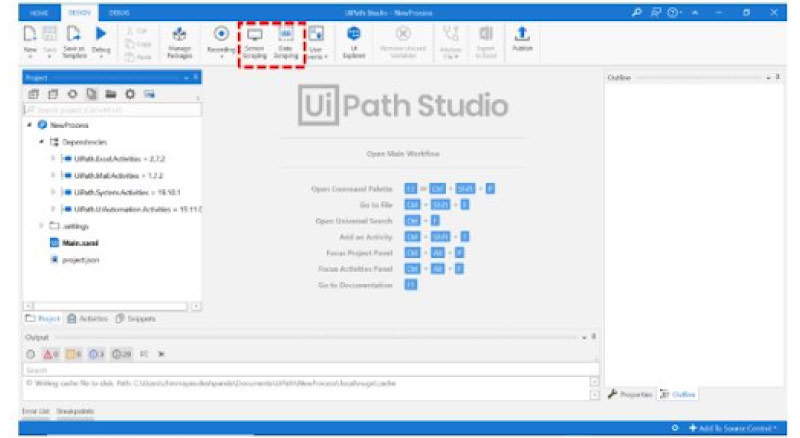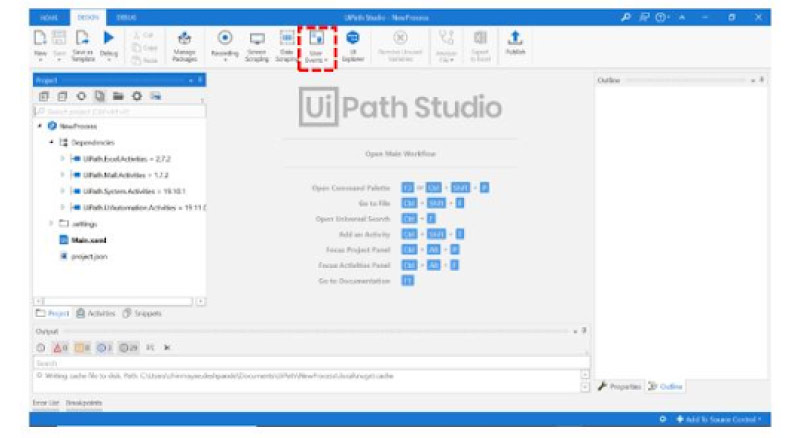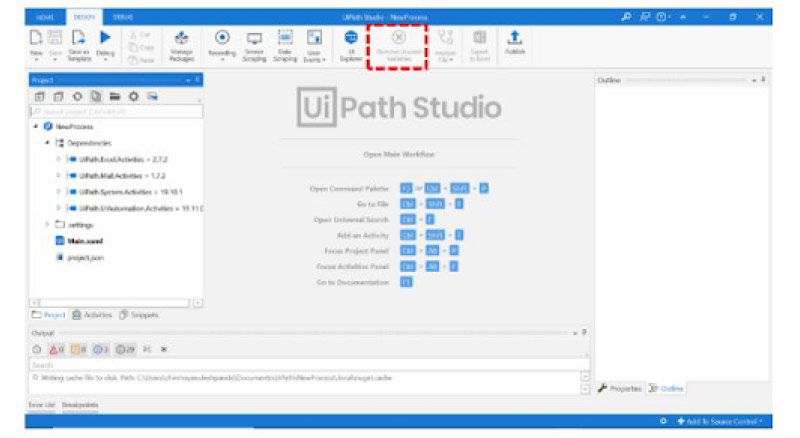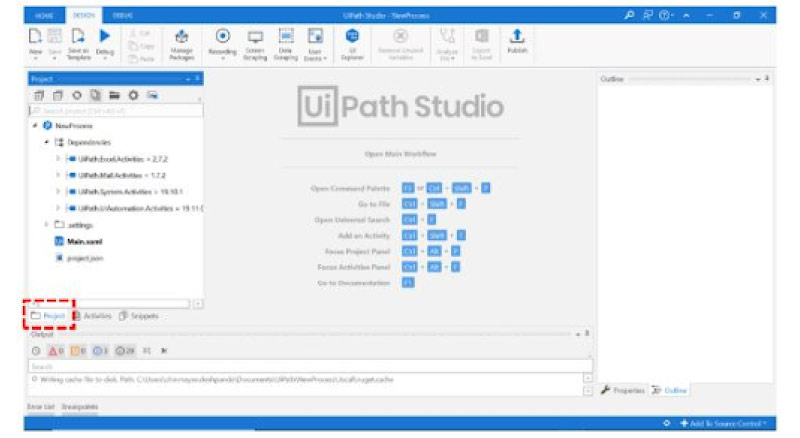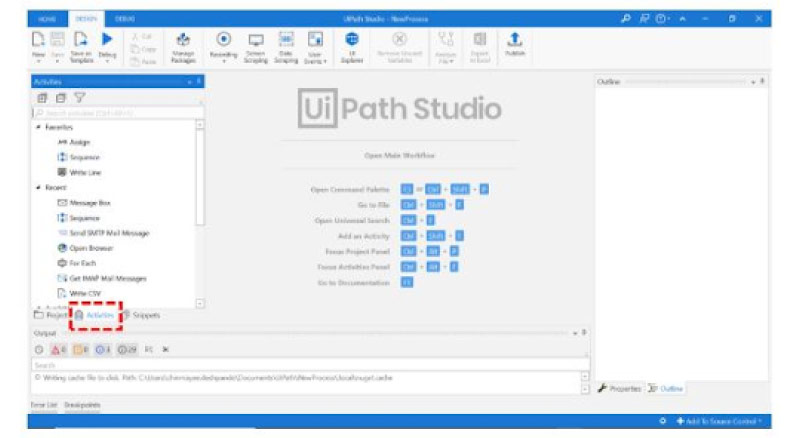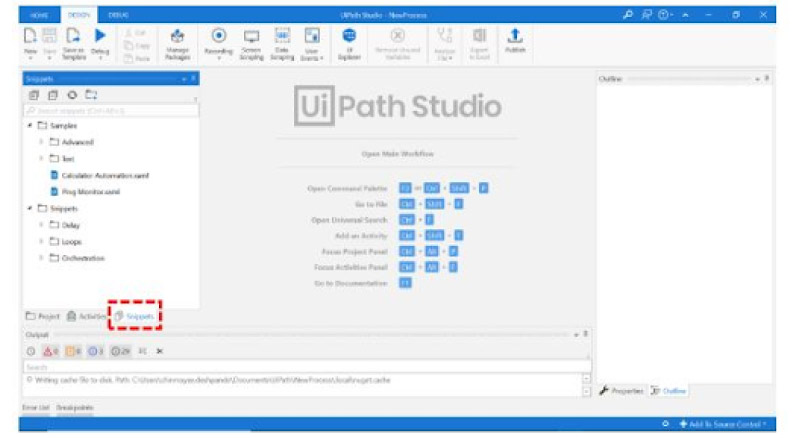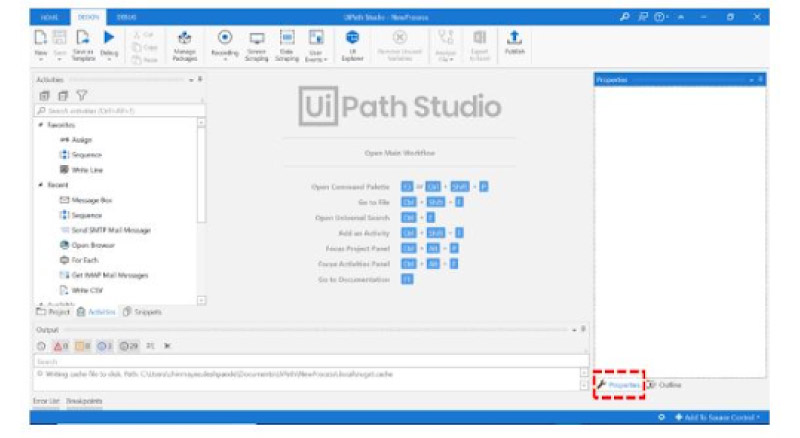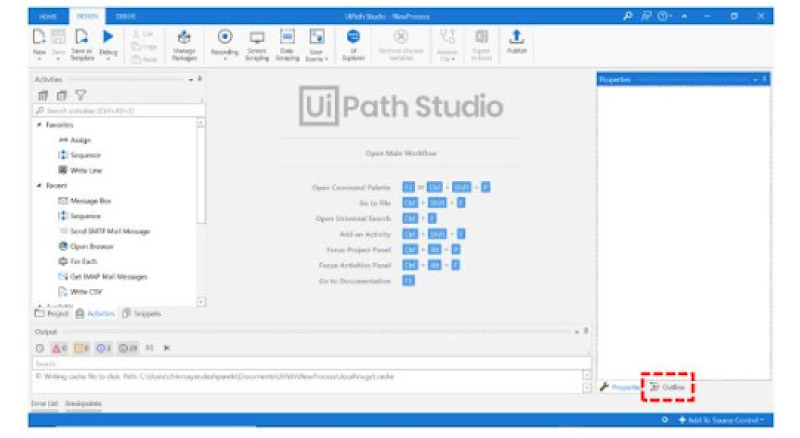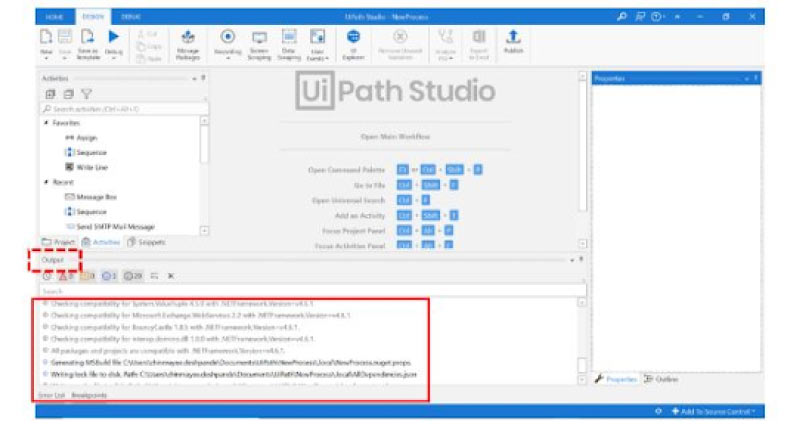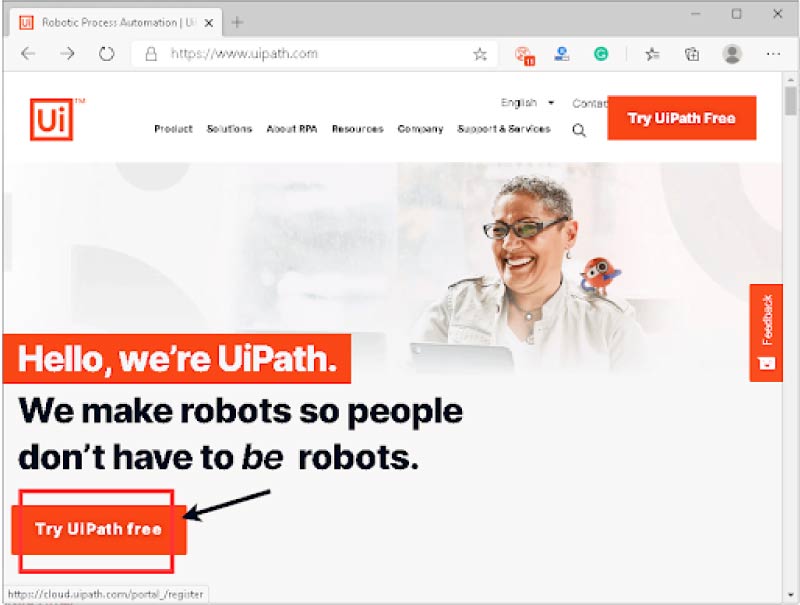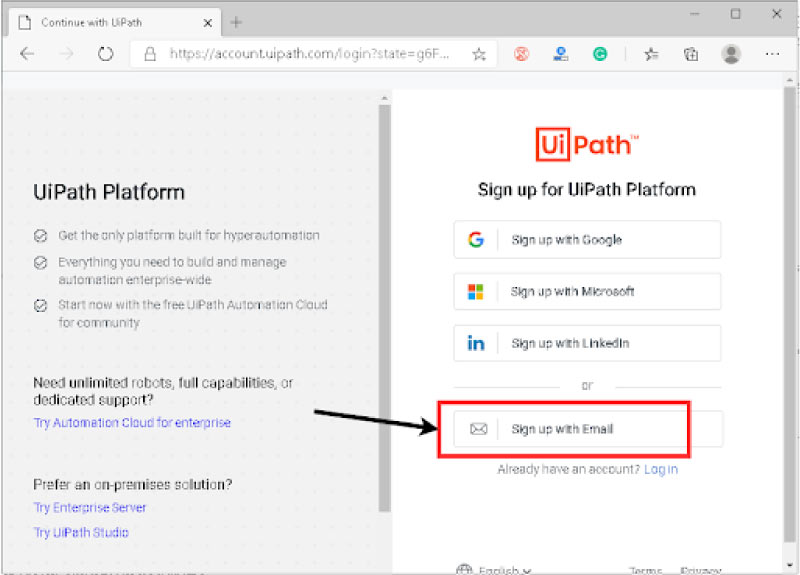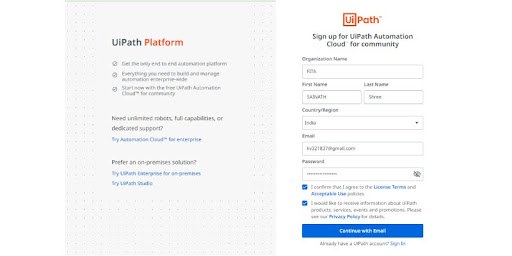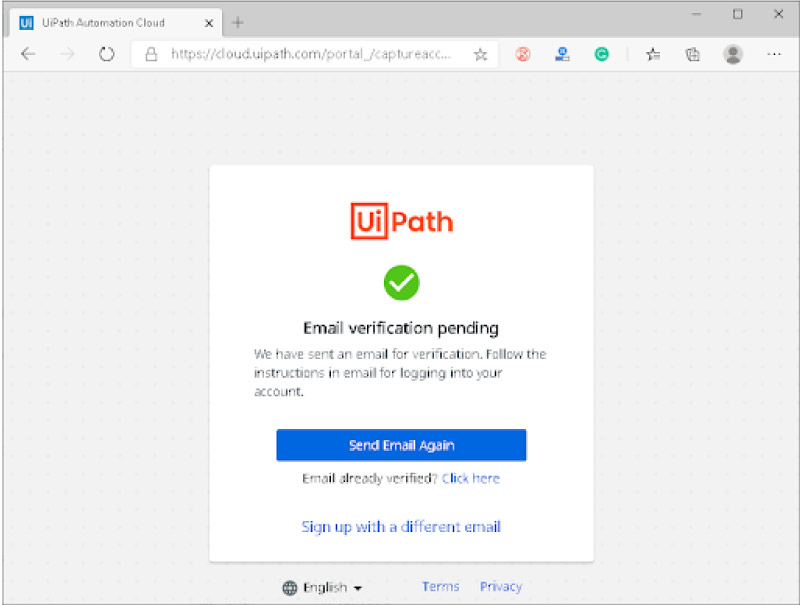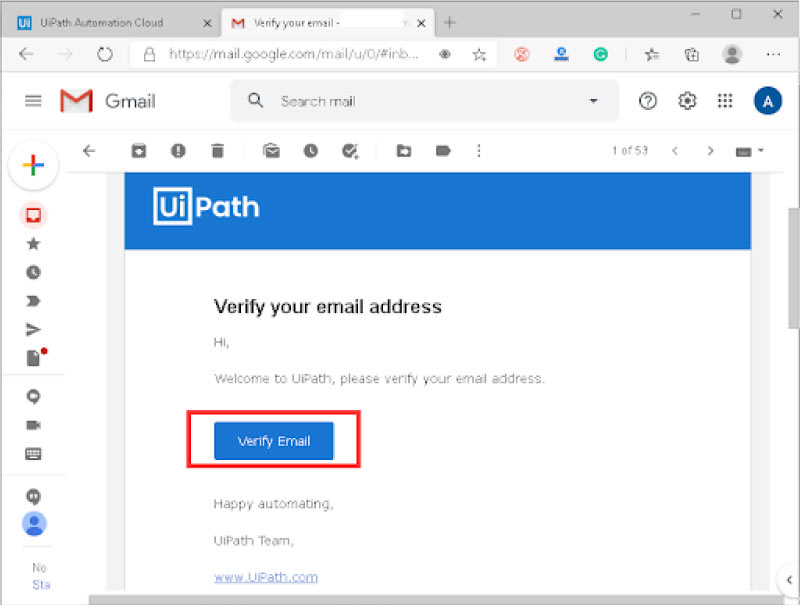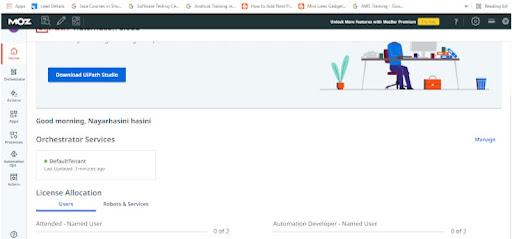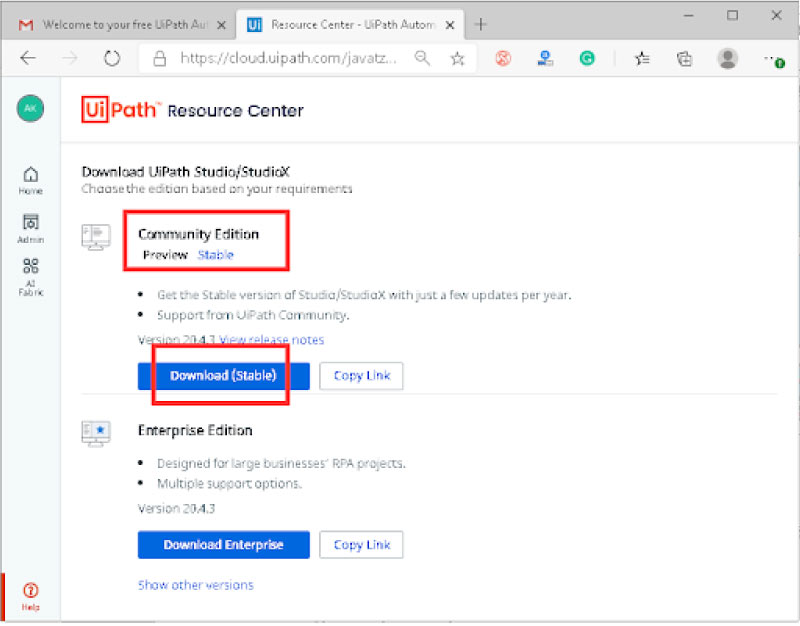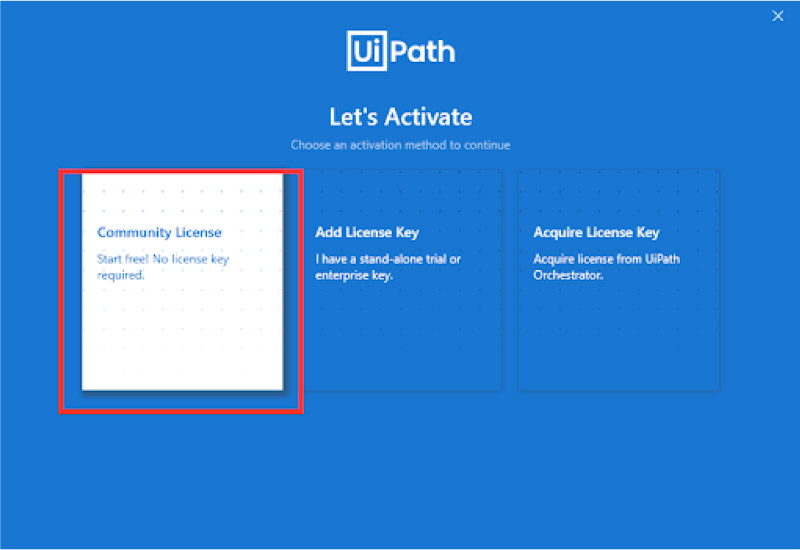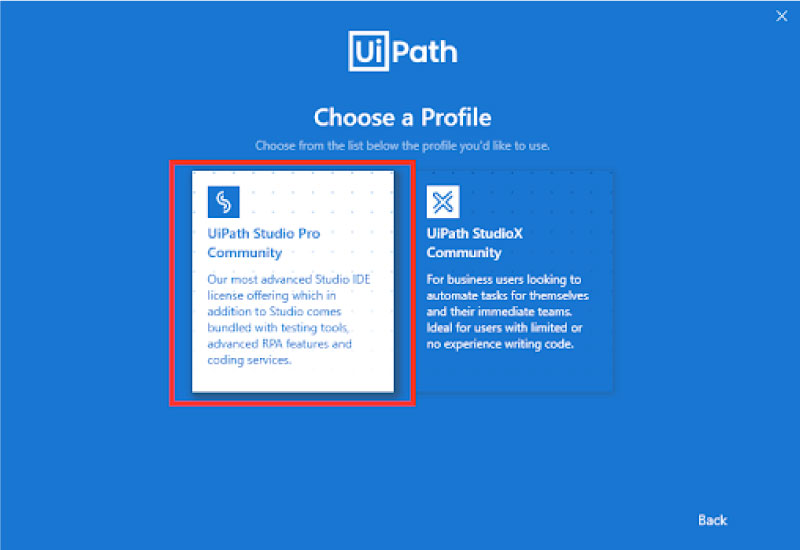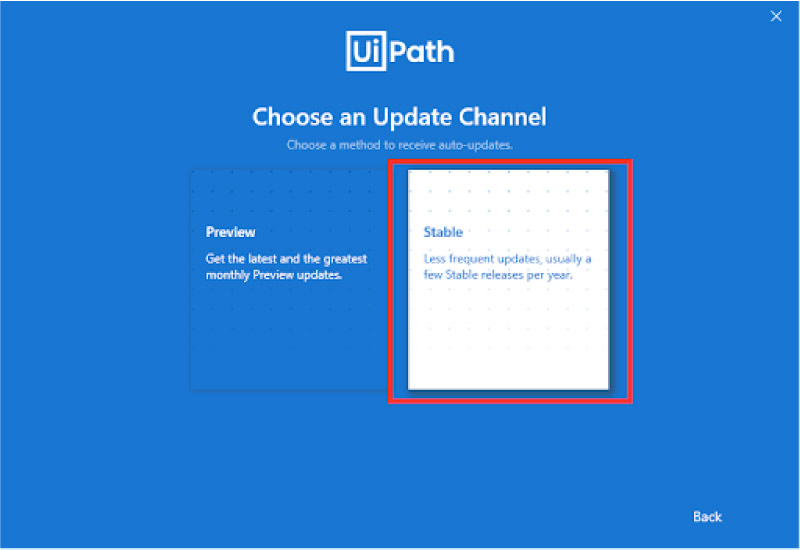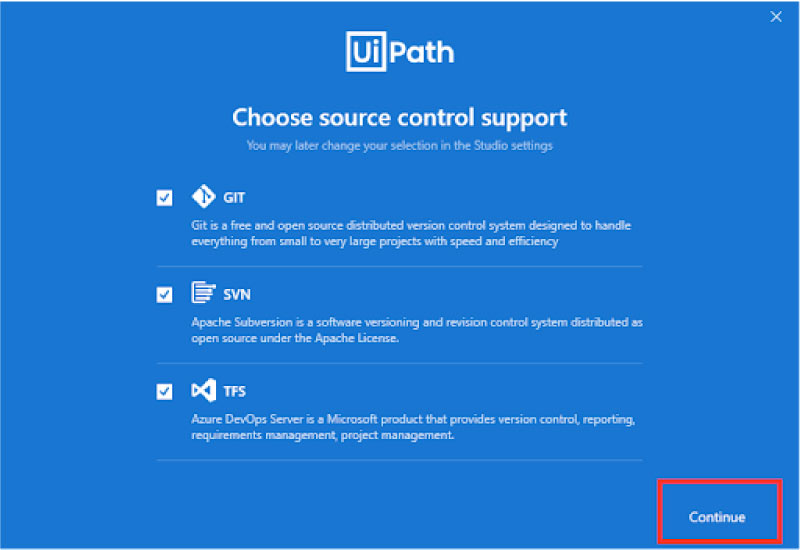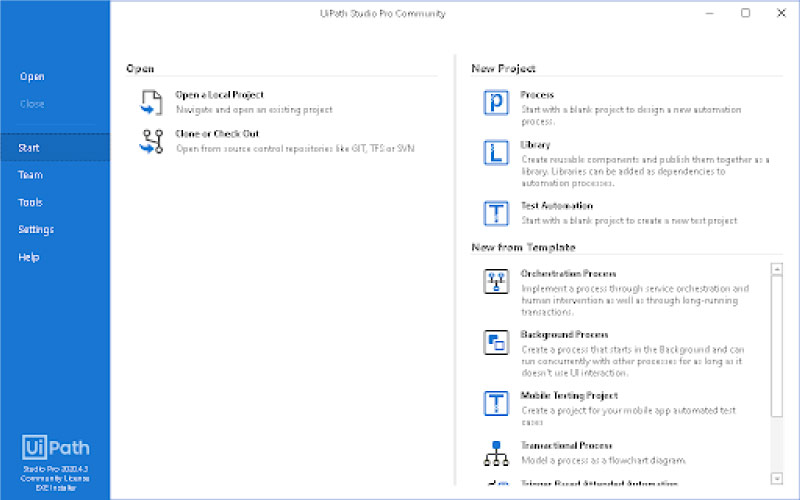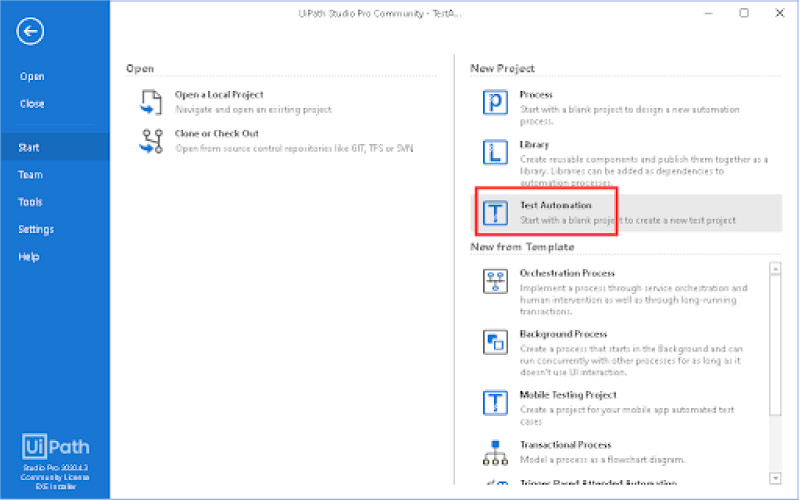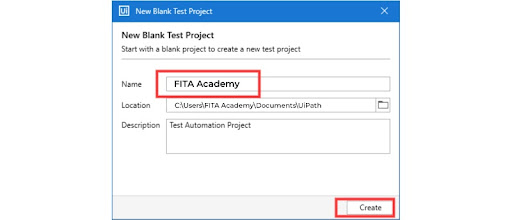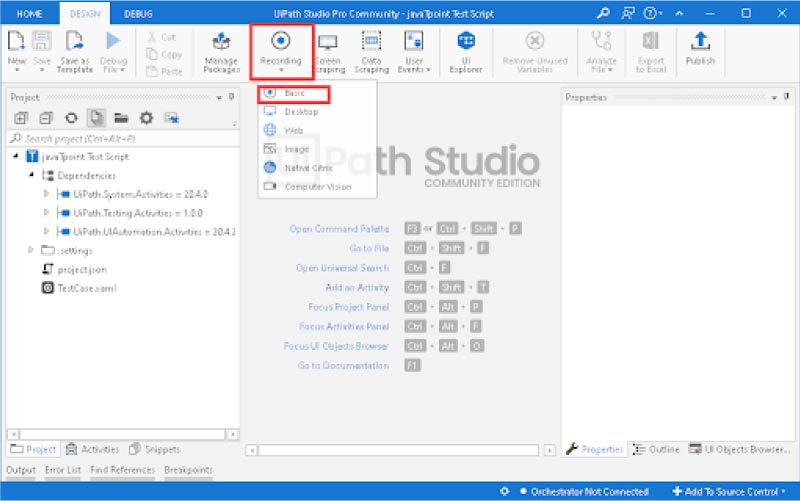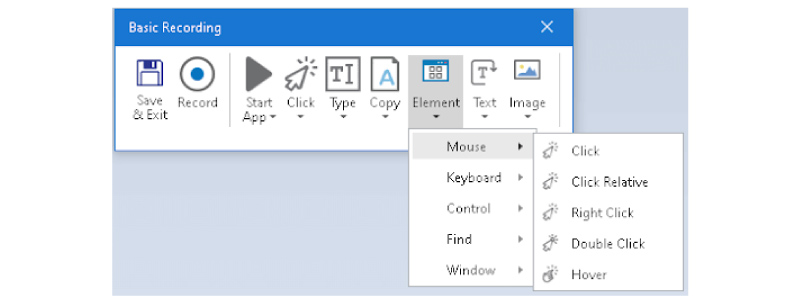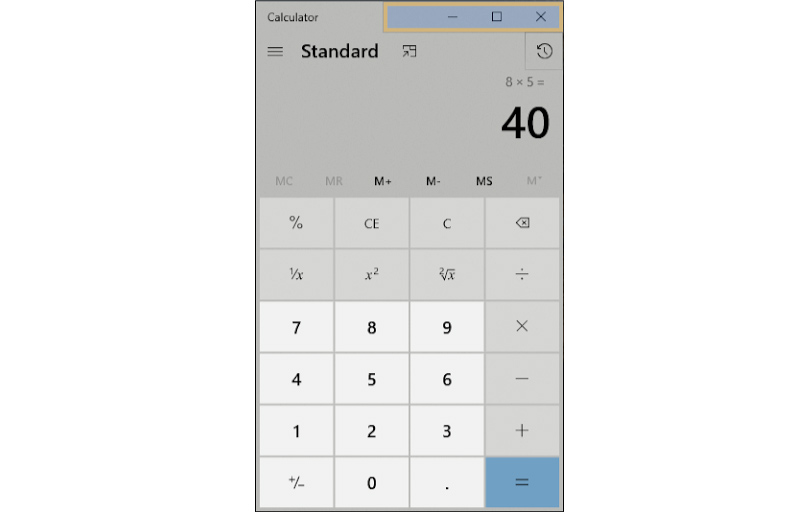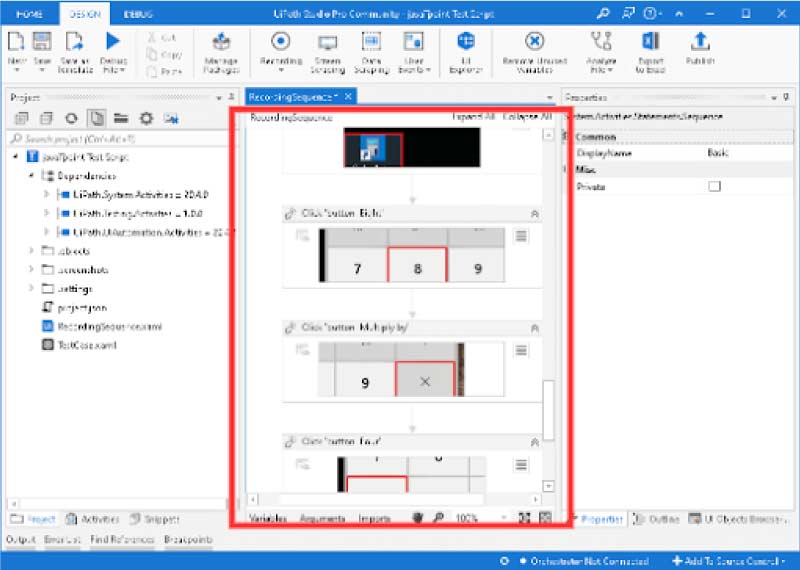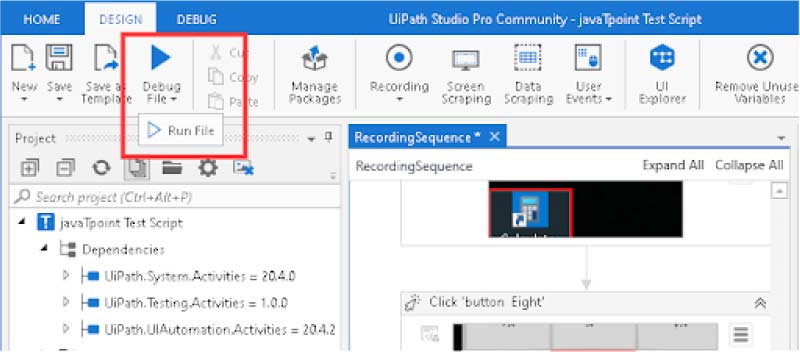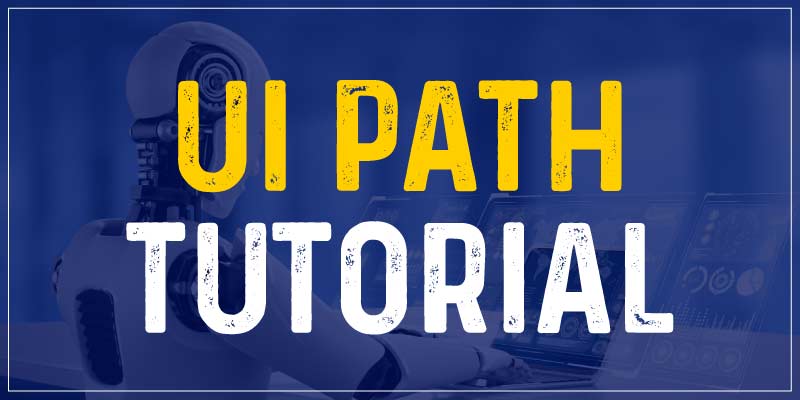
Introduction
Here in this UiPath Tutorial, we are going to see the role and function of the UiPath in Robotic Process Automation. But, before diving into the water of the UiPath tool function and feature let us have a short glimpse of What is RPA? And how it is beneficial to the businesses.
What is RPA?
Robotic Process Automation (RPA) is the technology that allows the deployment, handling, and building of bots to mimic human actions and thus interact with other digital software & systems. These are the bots that act just like us, and it has the feature imbibed in it which perceives what is displayed on the screen and replicates the action that is related to the query. Some of the operations that are performed by these bots are extraction of data, navigating systems, finding the data, and defining the actions.
The main intent of using the RPA in business is to streamline thedifferent workflows in the business and it, in turn, benefits the organization with improved flexibility, profitability, and responsiveness. Also, it in a way boosts the time of the employee as this technology immensely helps in reducing the redundant tasks that take place in an organization on a daily process. The RPA is a non-invasive technology that eventually helps rapid implementation and promotes digital transformations significantly.
This technology is highly suitable for automating the workflows that include legacy systems and the ones that need Database access, Virtual desktop infrastructure, and APIs.
RPA is a transformative technology as it aids organizations to get rid of mundane tasks - moving files, logging into the system and applications, copying, extracting, filling the forms, inserting data, and accomplishing the daily reports & analyses. Apart from this, the advanced bot is even more capable of performing the cognitive processes namely - engaging in chats, interpreting texts, comprehending the unstructured data, and implementing the advanced machine learning models to decide a complex situation.
When bots perform these repetitive tasks, we have more time to focus on innovations, interactions, collaborations and thus come up with a novel idea that benefits the business. Further, the businesses get the additional patron of adaptability, productivity, and resilience. And this indicates that RPA has completely modified the old methods of working.
Applications of RPA
- RPA is being widely implemented in industries like finance, healthcare, manufacturing, compliance, customer service, legal, and IT operations.
- RPA is one such technology that supports many kinds of industries to address its specific and operation issues in sound and new ways.
- Leaders from various functional areas like customer service and finance have expressed that RPA has tremendously helped them in most of their repetitive tasks and thus allowed them to yield more productivity with lesser errors.
- RPA, according to IT leaders, could be introduced with fewer disruptions. As these bots could easily function and access all its legacy systems. We can also rightly conclude that RPA is a key player in the digital transformation in today’s prevalence. Modern RPA technology provides more enterprise-ready platforms that are easily scalable.
- Also, the employees feel that it is easier to adapt to the Robotic assistant during their working phase. With its low-code feature, it allows the developers to come with more and more simple automation seamlessly.
Having seen about RPA, let us now step into the boat of UiPath software and its functions.
What is UiPath?
It is one of the advanced RPA tools that permit you to build automation processes visually with the aid of diagrams. The UiPath offers its users bundle-pack automation solutions or also we can call them "hyper-automation". The UiPath was initially found in the year 2005 and this is broadly used for Windows Process automation. The reason behind its wide popularity is that it could be deployed easily and it provides the best drag & drop options for enabling the exploration of features broadly.
The UiPath Training in Chennai at FITA Academy equips you proficiently with the UiPath software applications, features, and with its functions under the training of Automation Experts.
History of UiPath
Today, UiPath is the leading software across the global platform. Initially, it was launched in 2005 by Romanian Entrepreneurs - Marius Circa and Daniel Dines initially started in Bucharest, Romania. Then this was broadly used in different countries across the world. In April 2020, UiPath was regarded as the best tech company that offers RPA services.
Benefits of UiPath
In this UiPath tutorial for beginners, let us see the important reasons to use UiPath for RPA.
Security: The UiPath Software provides a high-level security system where you can stack in and encrypt all your credentials on the centralized server itself.
Library: It has a robust library with drag and drop pre-built actions.
Third-party Integration: We can easily plug into different technologies from Google and IBM Watson.
Recording: The UiPath software has emulators for faster development of automation and recorders for desktop apps.
Powerful Debugging: The UiPath provides flexible and intuitive debugging features.
Different Products offered by the UiPath
The UiPath supports its users with three products and they are -
- UiPath Studio
- UiPath Orchestrator
- UiPath Robot
Let us now see in detail about these products and their services.
UiPath Studio
It is the platform that is used for building automation bots. It includes more than hundreds of readymade components and templates to drag and drop. The key important features are discussed below:
- Types of Recorder: The UiPath Studio provides different kinds of recorders for recording the actions on different platforms.
- GUI Dashboard: It provides a Visual dashboard with actions like Display messages, Sends Email, and much more.
- Reusable Components: With UiPath studio the users can effortlessly develop reusable components to broadcast them along with the libraries.
- Exception and Log Handling: It provides different options for exception handling and debugging of Open logs and Slow Steps.
UiPath Orchestrator
This is the Centralized Robot Management dashboard where we could easily manage, deploy, and secure UiPath Robots at any scale.
A Course action of the UiPath Orchestrator are:
- The initial step is to build bots for executing a task.
- Now, the user must build a project that could be used later for other processes.
- As when the creation of a process is completed we can easily assign them to a particular bot and thus execute them in a particular environment.
- It cooperatively composes a job.
UiPath Robot
It runs the automation that is developed using the UiPath studio. We now have two different kinds of robots and they are:
Attended Robots - They operate to speed up the help desk and service desk. Used are the activities where involvement of human activities are high.
Unattended Robots - Here is where the bot operates without the touch of a human and thus maximizes the performance & cost-benefit of different back-office tasks.
Different Kinds of Bots in UiPath
The UiPath has two types of bots - Attended and Unattended Robots:
Attended Robots
The Attended Robots functions with the respective workstation as humans and it supports its users to get the task done regularly. These are the kinds of robots that are generally triggered by a user event. Also, it is not possible to use them at the beginning of any task from the Orchestrator and when the screen is locked. These bots are used only at the beginning of the Robot tray. Or they are used with the specific Command prompt. The Attended robots must run only when it is beneath the supervision of the humans.
Based on the licensing kinds, the Attended robots are further differentiated into the types that are given below:
Studio: It is used for connecting the Studio to Orchestrator for other development processes.
Attended: It functions on a similar workstation as the person and it is generally introduced via user events.
StudioX: It is used for bridging StudioX to the Orchestrator for other development processes.
StudioPro: It is used for bridging the connect StudioPro of the Orchestrator for other development processes.
Unattended Robots: The Unattended bots are generally called autonomous robots and they will need any human supervision at the time of executing tasks. These are the various kinds of robots that function primarily in virtual environments and we can automate numerous tasks at one specific time. It includes all the features for attending the robots. It is also held responsible for the other tasks namely monitoring, scheduling, remote execution and it provides different support for the process queue. Unattended robots are capable of executing any kind of task, process, and test case. When you use them for running the parallel processes all the present processes that are in operation deplete a unique license.
Based on the licensing types, the Unattended robots are further diversified into the below types:
Unattended: It functions well in virtual environments and automates many tasks without any intervention from the human.
Non-Production: It is mainly used in the unattended mode for other development processes. These are the different types of robots that are not capable of running any test cases.
Testing: It is used primarily in the unattended mode for other testing processes. Robots of these types are mainly used for executing test cases.
Features of UiPath
In this UiPath tutorial session, you will come to know the important features of the UiPath software and its functions. The UiPath has many features and they are:
Hosting Options: The UiPath could be easily hosted on numerous cloud environments and other virtual terminals to make this tool more flexible with the cloud platforms.
Centralized Repository: As UiPath has a centralized repository, different users can proficiently manage and control the robots concurrently.
Application Compatibility: It has very good compatibility with the web & desktop applications. The UiPath supports several applications and activities. When a tool supports both the Web and Desktop application it benefits automation significantly.
Security: Security is the key feature of the UiPath. The UiPath includes numerous security features persistently and thus helps you in adding through frequent updates:
The UiPath includes the setting of the account closure to protect its users from brute force attacks.
UiPath hampers the auto-submission of data over web browsers for all of its orchestrator credentials and input boxes. It is the feature that is used for protecting the user data and in the enhancement of overall security.
When the User Logs into different machines, the tools automatically identify and end their earlier login sessions. It indicates that similar login credentials could stay functional in the single system at a specific time while increasing the security features.
The UiPath is used for implementing the stealth mode and it could be used for executing the tasks on its background. It masks up the execution from a screen and it executes most of its tasks calmly.
A reliable tool to Model the Business Process: The UiPath provides more reliable tools to develop the automation capabilities and its excellence with other business process models.
Advanced Screen and Scraping Solutions: UiPath has an advanced screen and scrapping feature which can function with different applications like SAP, Java, Dot Net, PDF, and Flash. With the advanced screen scraping solution, the users could easily reach the maximum possible accuracy when compared to the other automation tools that are found in the market.
Robustness & Scalability: The UiPath tool is highly scalable and robust and it comes with
It comes with effective and efficient debugging support along with exception handling of the systems.
Also, Artificial Intelligence techniques are used for controlling regular applications like Outlooks, PDFs, and Excel.
UiPath Workflow
A Workflow is a compilation of numerous processes that are merged as a single task. A Workflow is generally executed similarly to that of the individual task on the executed UiPath. The functions of the Workflow are obtained from the important activities of the pack and it includes fundamental activities that are needed to develop and design the automation tasks on the UiPath.
The activities that are permitted by these software robots perform the tasks that are listed below:
- Automate or Recreate human activities and actions like form-filling, working with the mouse & keyboards, comparing data, and extracting content.
- Obtaining data using the Image Recognition techniques and OCR using automated methods.
- Perform Web automation, Interaction, Browser automation, and Data-manipulation.
- Create trigger-based activities and actions for enabling the automation feature on the machine.
- We can easily perform the other mundane functions on the machine just like a human.
- You work on the data by getting more details from the machines like error logs and systems logs.
A Workflow includes many functions along with the complete flow of the tasks. The other important functions are presented in the table below:
|
Activity |
Syntax |
Action |
|
For Each |
UiPath.Core.Activities.ForEach |
It is used for applying any specific function or set of functions on all the elements of a component. |
|
Break |
UiPath.Core.Activities.Break |
This is used for performing the Exit of the present Each activity and then move them to the next activity of a workflow. |
|
Retry Scope |
UiPath.Core.Activities.RetryScope |
It is used in retrying the activities that exist already and till the condition is identified or whether an error is thrown outside. |
|
Check True |
UiPath.core.Activities.CheckTrue |
It is used for cross-checking whether the applied Boolean expression is True. Or it shall be sent back as an error when it is not. |
|
Check False |
UiPath.Core.Activities.CheckFalse |
This is used for checking whether the used Boolean expression is False. Or it shall send it back as an error when it is not. |
|
Invoke Workflow File |
UiPath.Core.Activities.InvokeWorkflowFile |
This is mainly used to initiate the workflow in sync with or without the arguments. |
|
Continue |
UiPath.Core.Activities.Continue |
It is used for skimming the present iteration that is identified right inside For Each Loop. |
The UiPath Online Training at FITA Academy holistically explains to you the role and functions of UiPath in the RPA with real-time examples and case studies.
Processes that can be automated using the UiPath
Here in this UiPath RPA Tutorial, you will be covered with different processes through which the automation processes are enabled.
Though UiPath can undoubtedly offer operational improvements it also offers numerous options for automation with which the business process is being benefitted highly. Today, for any business to have a good ROI, it must optimize its business operations efficiently, and to do that automation is one of the best solutions. And more importantly, the business must use the best processes for business automation.
Listed below are the important terms that help the enterprises to find the processes that could automate their operations using the UiPath software:
Human Involvement
Many organizational processes are usually time-consuming and redundant. Over here, the organizations highly rely on humans to accomplish these works. However, in actual, these processes may not need human intelligence as much as it seems to be. These processes are nothing but something that includes claims processing, handling customer databases, order processing, and data migration. Processes of these kinds are highly suitable for automation processes. When you automate the process of these kinds it will immensely reduce the complete time taken and the execution of all these tasks with fewer errors and make them function rapidly.
Further, the employees included in these manual processes would have some additional time to concentrate on things and tasks that need human intervention and intelligence.
Volume
In most businesses, there are no time frames or limitations. This means there could be more number requests, orders, or complaints while considering holidays. When the enterprise mainly relies on human employees, the workload is more difficult to handle. Hence, the processes could be easily automated using the UiPath bots. These are the bots that function 24/7 and all the days of the year. Robots are a highly productive and efficient choice to perform all these volume tasks.
Complexity
The UiPath could be in a complex process like accounts payable and fraud detection. Though these complex processes have a great deal of investment and time for automation, this software is highly preferable for processes that need more impact on the business operations.
Difficulty in Outsourcing
Usually, in most business processes, we need a high level of regulatory compliance. These processes are tedious to handle when it comes to security grounds. It is because these types of processes need higher precision of control and oversight. We can see the process of these kinds in the BPO and Financial sectors. With the UiPath robots, the enterprise could build a more robust and secure compliance strategy.
Stability and Standardization
The UiPath is highly preferable for processes that are consistent, data-driven, and rule-based. Processes of this kind are definable and it takes place the same way as the rest other time. The Back-office processes rightly come under processes and they are termed to be applicable for automation as it aims to be highly repetitive and transactional. These processes include claims processing, account openings, management, and transaction duplication. On the other aspect, front-end office automation is possible when it highly relies on the complexity of a process.
UiPath Architecture
Here in this UiPath tutorial, we are going to see about the fundamental architecture of the UiPath software. The UiPath architecture primarily consists of three main layers and they are:
Client Layer
A Client Layer includes UiPath Robot and UiPath Studio. The users could build the automation workflow and function proficiently with the UiPath robot for executing all the tasks.
The UiPath has two main components and they are
UiPath Agent Service
It is the service that is used for showcasing the jobs on the system tray. Also, it is used for managing the start/stop changes and requests.
UiPath Executor Service
It is the service that runs and provides the job right under a Window's session.
Persistence Layer
It is the layer that consists of the database and it handles items and queues. Also, this holds the details of robot configuration and the processes that are assigned to it.
Server Layer
When the robot is all set to execute its tasks, the projects could be easily uploaded to the Orchestrator Server. With the aid of Orchestrator, the projects are used for running different PCs. An Orchestrator monitors the configures, queue management, deployment, and logging.
UiPath Components
Having seen the fundamental architecture of the UiPath software, in this UiPath for beginners, you will see the other important components that are related to the UiPath software.
The Ribbon
A Ribbon consists of the following:
Home: We can begin a new project using the defined templates or we can open the project on which you have worked recently. The projects that were created and saved by default in:
C:
↓
Users
↓
<current_user>
↓
Documents
↓
UiPath
DesignIt is the feature that permits you to add the flowcharts, sequences, and state machines of a project. It permits you to manage and install all the packages, create interactions using UI elements, activities, and publish all your work to the Orchestrator.
Debug
We can debug the workflow using debugging tools like breakpoints. We can check the monitor and execution of all the activities in a procedural manner and alter them based on the debugging speed.
Tools
The Tools tab is mainly used to install the extensions of different browsers namely Firefox, Edge, Chrome, Citrix, and Windows Remote Desktop for downloading the Dependencies of Mass Update tool and UI Explorer.
Settings
A Settings tab has many options to modify the interface language theme, handling activity feeds and setting the global preference.
General
Language - It includes options that are used for modifying the interface language of Robot and Studio.
Theme - A Studio Interface theme could be easily adjusted from light to dark based on the preferences.
A Reset Setting button helps in setting all Design and General settings on the studio right to its default state.
Telemetry - This allows you to enable or disable the data usage.
Designs - It consists of a group of global settings which are used on all the projects and it is opened in the studio.
Publish and Save - It assures timely back-up and curbs you in publishing the projects without any errors.
Execution - An Output console is a size that is set up to 9999 lines on a specific session which is interpreted on the Output panel.
Activities design - It is used for developing docked annotations toggle that permits you to build floating or docked annotation for any activities.
Locations
Publish Library URL - It permits you to add the default location where all the libraries and it publishes when a custom feed option is chosen.
Publish Process URL - It allows you to offer a default path where all the processes are published and when a custom feed option is chosen.
Project Path - This is used for modifying the default location where all the projects are developed.
Manage Sources - It is the feature that handles the feeds for all activities and packages that are from without having an open project. It is the feature that resembles the one that is found in the Manage Packages Windows and it allows you to alter based on the feeds of a project.
License and Profile
This is used for activating the enterprise or community license with the orchestrator.
Help
A help feature allows you to direct product documentation, online resources, community forum, release notes, and RPA Academy. The details associated with product version and installation, license availability and update device, and the channel is identified on the Help page.
Recording
A recorder component in the UiPath studio permits users to record the keyboard activities and UI mouse movements for generating the automation scripts.
Scrapping
These components permit Data Scraping - Extraction of Structured Data from the application and Screen Scraping - Programmatic compilation of Visual Data.
User Events
A User event records all events like keystrokes and clicks
Variables
The Variables hold various kinds of data. These variables could change over time. The UiPath makes it easier for provisions to build and discard all the unused variables.
Project
A Project Panel permits you to view the content of the present project for opening the file of the present location, handling dependencies, adjusting the project settings, and adding folders.
Activities
This panel shows the activities that are available and the ones that could be added to the present workflow. We can make use of the search box for finding activities and moving with them using the navigation press and keys.
Snippets
A Snippet panel permits you to reuse the automation. It includes more snippets and samples by default.
Properties
A Property panel permits you to view & modify the properties based on select property.
Outline
An Outline panel helps in interpreting the hierarchy of a project, all its nodes, and variables. The activities are listed in the panel you can select them right from a designer panel.
Output
An Output panel allows you to demonstrate the output of a Log Message. Any Exceptions that are included in this package are also listed on this panel.
UiPath Installation
Right before moving into the installation process, here in this UiPath tutorial, let's see the various versions of the UiPath in short:
Studio: It is the version that is mainly used by individuals on the enterprise level.
Community Cloud: This version is highly preferable for individuals who need to get their basics right off the UiPath practice and automation tasks.
Enterprise Cloud: It is the version of the UiPath that is developed based on the Robots, Orchestrator, and Consists of the studio. This version is used by big enterprises.
Enterprise Server: A Enterprise Server of the UiPath is called the on-premise version of the complete automation platform. It encompasses Robots, UiPath Studio, and Orchestrator. It is the version that is primarily used in the automation of large-scale platforms.
In this UiPath tutorial for beginners, we will guide you on how to install the Community Cloud edition of the UiPath. The process of the installation is the same for all its versions. The UiPath Community Cloud is absolutely a free edition. On the other hand, the rest of the other versions comes with a restriction of 60 days trial period. Given below are the important steps that are involved in the installation of UiPath:
Step 1: Initially, you must move to its official site using the link: https://www.uipath.com/
Step 2: Now, you can click the button "Try UiPath Free" as given in the below image:
Step 3: On your next screen, you can see the various versions of the UiPath which is found on the left side of the page and now you can them up as given below:
Right here, we must sign up using the Google account, Email, LinkedIn, or Microsoft account. Use the option "Sign Up with Email".
Step 4: After you click on the " Sign Up with Email" option, you will get the form collecting some of your details as interpreted in that image which is shown below:
Step 5: Once when you submit the form, you will receive the verification mail on your submitted email-id.
You must log in to the email account and choose the option "Verify Email"
Step 6: On clicking the "Verify Email" option, you would be redirected to the home page of UiPath Automation Cloud that is customized by default. Over here click on the link that is highlighted as given in the image:
It will now showcase all the packages and resources of the UiPath that are available.
Step 7: On your next screen, you must download UiPath. Right here, you can download the standard version of the "UiPath Community Edition".
Step 8: Once, when you are done with the download option, you must double-click the UiPath setup file option, to begin with, the installation process. As you install the setup, a screen will be displayed to pick the license type. You can select the "Community License" option here.
Step 9: Now, you must choose the correct profile that is between "UiPath StudioX Community" and “UiPath Studio Pro Community”. Here, choose the option "UiPath Studio Pro Community"
Step 10: Then you must pick either between the "Preview" or "Stable" UiPath version. We can now pick the "Stable" edition.
Step 11: In your next screen, we must choose the correct source to control support and choose the "Continue" option. You can leave the setting based on the recommendations suggested by the UiPath.
Step 12: When you complete these on-screen protocols, you will be directed to the main screen of the UiPath, as depicted in the image:
We can now begin with the automation work or project with the present needs.
The steps for installing and configuring UiPath are outlined here.
Procedure for building a Simple Script in the UiPath
You can build the automation script with the help of this tool. You will get a comprehensive view of how it functions and the methods for creating a script that will immediately perform all the pre-recorded functions by just executing the script.
Step 1: Initially, you must choose the "Test Automation" option as given in the image.
Step 2: Now, on your next screen, you must enter the project's name and select the "Create" option:
Step 3: Once, when you click on the "Create" option, the blank project is developed. You can now click the "Basic" and "Recording" option from the top panel.
Step 4: When you choose " Basic", it opens the new pop-up windows with different recording tools:
Step 5: You are needed to tap on the "Record" option:
Now, choose the "Record" option which is on the cursor, then it will turn the hand icon and the complete screen will turn to blue, focusing all the objects. We can now perform the manual tasks that are used for recording tools. You can use the calculator application and thus record a simple calculation:
Step 6: When you complete the task, you can click the "Save & Exit" option:
Step 7: The complete process is recorded and the workflow is displayed as given in the image:
Step 8: You can run the script by using the "Run" option as given below:
The execution would repeat and the complete action is performed on a screen. By using the method, you can easily build automation tasks that are small. The UiPath consists of advanced templates and features that aid you to automate the tasks that are complex.
The UiPath Training in Bangalore at FITA Academy is a well-intended training program that equips the learners of the UiPath Course to become well-equipped with the UiPath tool, Workflow, Architecture, Component, and Automation process. By the end of this UiPath Training program at FITA Academy, you will have gained a good understanding of the UiPath automation concepts and techniques.
Different Project types and Templates in the UiPath
Projects
Library: It is the kind of project that is used for building reusable components and you can publish them easily as a library. Libraries of these types could be further utilized as the dependencies for all the automation processes.
Test Automation: It is the kind of project which is used for developing the new test project.
Process: This is the kind of project that is used for building the new automation process.
Templates
Background Process: It is the template that is used when you need a process that executes the complete background with the rest of other processes as long as it does not communicate with the UI.
Orchestration Process: It is the template that is used for deploying a process via human intervention and orchestration. These kinds of templates are also utilized in transactions that are long-running by nature.
Transactional Process: It is the type of template that is mainly used on the model workflow automation using the flowchart diagram.
Mobile Testing Project: It is the template that is predominantly used for developing mobile apps and automated test case projects.
Robotic Enterprise Framework: It is the template that is used for building the transaction business process. This is best applicable for deployments that have to be made on a larger scale.
Trigger Based and Attended Automation: It is the type of template that is used when you are required to trigger the automation task in correspondence to the keyboard strokes, mouse clicks, and other activities.
Career Opportunities of UiPath
Today, the application of the RPA tool is growing manifold times than it was earlier. However, presently the UiPath has created a buzz in many organizations. It has more User acceptance and scope while comparing the other RPA tools in the market. It is because this tool has drastically improved performance and productivity at an optimized cost. Hence, the future of the UiPath seems to be stable, and that investing your time in learning the UiPath tool for RPA will surely help you to land the best career path. With its constant up-gradation with the recent trends in the marketplace, this tool has occupied a prominent position in the market. Based on the survey reports of Brand Essence Research, the global value of the RPA market is expected to soar up to USD 18339.95 million by the end of 2027 with an overall CAGR of 31.07%. Apart from this, the packages that are offered to the professional on completing the UiPath certification are significantly high.
EndNotes
EndNotes: We hope you found this RPA UiPath tutorial useful. In the upcoming days, we will do a timely update of this tool. FITA Academy offers both UiPath Online and Classroom Training in various locations in Chennai with Expert mentorship and Placement support.
Interview Questions
Interview Questions on Digital Marketing Java Interview Questions For Experienced Selenium Interview Questions and Answers For Experienced Hadoop Interview Questions and Answers For Experienced Python Interview Questions and Answers For AWS Interview Questions and Answers For Experienced DevOps Interview Questions and Answers Oracle Interview Questions PHP Interview Questions For Freshers AngularJs Interview Questions RPA Interview Questions Software Testing Interview Question and Answer Mobile Testing Interview Questions and Answers Salesforce Interview Questions Networking Interview Questions and Answers Pega Interview Questions NodeJS Interview Questions Ethical Hacking Interview Questions Data Science Interview Questions and Answers Javascript Interview Questions Blue Prism Interview Questions SEO Interview Questions Android Interview Questions MS Excel Interview Questions Cloud Computing Interview Questions Cyber Security Interview Questions Interview Question on Tableau Power BI Interview Questions and Answers Artificial Intelligence Interview Questions and Answers Azure Interview Questions and Answers SQL Interview Questions and Answers Full Stack Interview Questions and Answers Dot Net Interview QuestionsFull Stack Interview Questions and Answers UI UX Interview Questions and Answers ReactJs Interview Questions Full Stack Interview Questions and Answers Linux Interview Questions
FITA Academy Branches
Chennai
Contact Us
- Chennai:93450 45466
- Bangalore:93450 45466
- Coimbatore:95978 88270
- Pondicherry:93635 21112
- Madurai:97900 94102
- Online:93450 45466
For Business
Testimonials
Resources
Follow Us
TRENDING COURSES
JAVA Training In Chennai Core Java Training in Chennai Software Testing Training In Chennai Selenium Training In Chennai Python Training in Chennai Data Science Course In Chennai C / C++ Training In Chennai PHP Training In Chennai AngularJS Training in Chennai Dot Net Training In Chennai DevOps Training In Chennai German Classes In Chennai Spring Training in ChennaiStruts Training in Chennai Web Designing Course In Chennai Android Training In Chennai AWS Training in Chennai
iOS Training In Chennai SEO Training In Chennai Oracle Training In Chennai RPA Training In Chennai Cloud Computing Training In Chennai Big Data Hadoop Training In Chennai Digital Marketing Course In Chennai UNIX Training In Chennai Placement Training In Chennai Artificial Intelligence Course in ChennaiJavascript Training in ChennaiHibernate Training in ChennaiHTML5 Training in ChennaiPhotoshop Classes in ChennaiMobile Testing Training in ChennaiQTP Training in ChennaiLoadRunner Training in ChennaiDrupal Training in ChennaiManual Testing Training in ChennaiWordPress Training in ChennaiSAS Training in ChennaiClinical SAS Training in ChennaiBlue Prism Training in ChennaiMachine Learning course in ChennaiMicrosoft Azure Training in ChennaiSelenium with Python Training in ChennaiUiPath Training in ChennaiMicrosoft Dynamics CRM Training in ChennaiUI UX Design course in ChennaiSalesforce Training in ChennaiVMware Training in ChennaiR Training in ChennaiAutomation Anywhere Training in ChennaiTally course in ChennaiReactJS Training in ChennaiCCNA course in ChennaiEthical Hacking course in ChennaiGST Training in ChennaiIELTS Coaching in ChennaiSpoken English Classes in ChennaiSpanish Classes in ChennaiJapanese Classes in ChennaiTOEFL Coaching in ChennaiFrench Classes in ChennaiInformatica Training in ChennaiInformatica MDM Training in ChennaiData Analytics Courses in ChennaiFull Stack Developer Course in ChennaiHadoop Admin Training in ChennaiBlockchain Training in ChennaiIonic Training in ChennaiIoT Training in ChennaiXamarin Training In ChennaiNode JS Training In ChennaiContent Writing Course in ChennaiAdvanced Excel Training In ChennaiCorporate Training in ChennaiEmbedded Training In ChennaiLinux Training In ChennaiOracle DBA Training In ChennaiPEGA Training In ChennaiPrimavera Training In ChennaiTableau Training In ChennaiSpark Training In ChennaiGraphic Design Courses in ChennaiAppium Training In ChennaiSoft Skills Training In ChennaiJMeter Training In ChennaiPower BI Training In ChennaiSocial Media Marketing Courses In ChennaiTalend Training in ChennaiHR Courses in ChennaiGoogle Cloud Training in ChennaiSQL Training In Chennai CCNP Training in Chennai PMP Training in Chennai OET Coaching Centre in Chennai
Are You Located in Any of these Areas
Adyar, Adambakkam, Anna Salai, Ambattur, Ashok Nagar, Aminjikarai, Anna Nagar, Besant Nagar, Chromepet, Choolaimedu, Guindy, Egmore, K.K. Nagar, Kodambakkam, Koyambedu, Ekkattuthangal, Kilpauk, Meenambakkam, Medavakkam, Nandanam, Nungambakkam, Madipakkam, Teynampet, Nanganallur, Navalur, Mylapore, Pallavaram, Purasaiwakkam, OMR, Porur, Pallikaranai, Poonamallee, Perambur, Saidapet, Siruseri, St.Thomas Mount, Perungudi, T.Nagar, Sholinganallur, Triplicane, Thoraipakkam, Tambaram, Vadapalani, Valasaravakkam, Villivakkam, Thiruvanmiyur, West Mambalam, Velachery and Virugambakkam.
FITA Velachery or T Nagar or Thoraipakkam OMR or Anna Nagar or Tambaram branch is just few kilometre away from your location. If you need the best training in Chennai, driving a couple of extra kilometres is worth it!
© 2020 FITA. All rights Reserved.


